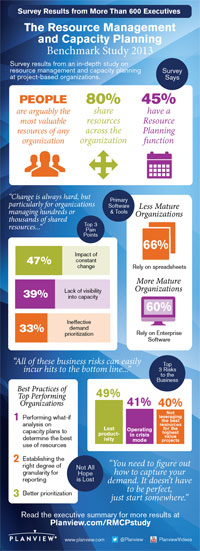Are your resources focused on the right opportunities? Unfortunately, many organizations can’t answer the question. Can you?
This is an ideal time and opportunity to benchmark your organization’s capabilities and maturity level in terms of resource management and capacity planning. I’ve had the pleasure to be the chief researcher on the most comprehensive study ever on resource management and capacity planning at complex, global organizations. With more than 600 participants from more than 17 countries, we’ve identified the state of their organization through the lens of a maturity model, designed for specifically for this research (2013).
Many organizations are continuing to operate in a state of chaos or limited visibility into what their resources are working on today and what they are available to do tomorrow. A third of organizations have achieved some level of visibility but have to continue to significantly improve productivity; and a third of organizations have made good, steady progress to truly gaining control and optimizing their resources. It is this top third, or even the top 5% of truly optimized organizations, that have some very interesting characteristics and best practices that all organizations could follow to intentionally move up the maturity spectrum (2013).
Here is a brief look at some of the findings of the study (2013). Get your copy of the Resource Management and Capacity Benchmark Study today.
- 80% of organizations are using shared resources and often in multi-country, dispersed locations to deliver projects, products, and services.
- The top business risks are “lost productivity” and “remaining in crisis mode.” The risk of remaining in crisis mode reduces by half or more as organizations move up the maturity spectrum. “Delayed time to market” is also a key risk of not addressing these areas.
- The top pain point is “constant change,” followed by “not enough visibility into capacity,” and “ineffective demand prioritization.” Lower maturity organizations have less insight into demand making project prioritization challenging.
- Two-thirds of organizations are in low to mid-tier maturity brackets.
Software is used by mature organizations; lower maturity organizations tend to rely upon spreadsheets and basic project.
The study warns if organizations do not get control of their resource management and capacity planning challenges they risk lost productivity, not leveraging resources for high-value projects, losing time to market and basing decisions on bad data (2013).
This is just a glimpse into the findings of the study. The report provides a deeper look into the characteristics and best practices of higher maturity organizations. There are a host of tangible recommendations to intentionally address these areas more proactively. In the words of one of the participants, the best way to improve is to “just do it”, start small, and find pockets of success and then continue to address these critical areas of resource management and capacity planning. The research shows that organizations that have graduated from chaos into control are addressing much more strategic, competitive business decisions versus wondering (or hoping) that their precious resources are working on the highest priority opportunities.
I’d like to hear from you. How do you ensure your resources are working on the right work? Post a comment or ask me a question pertaining to the research by leaving a comment below.
Carlson, M. (2013). Benchmark-Studie zur Kapazitätsplanung im Ressourcenmanagement . Planview.





